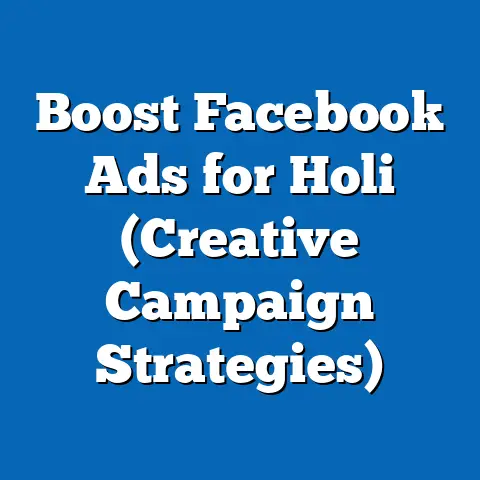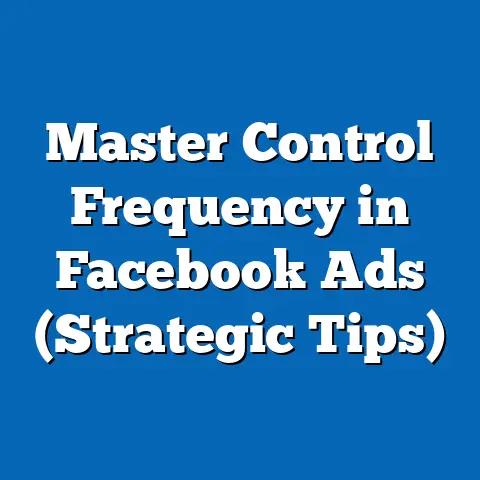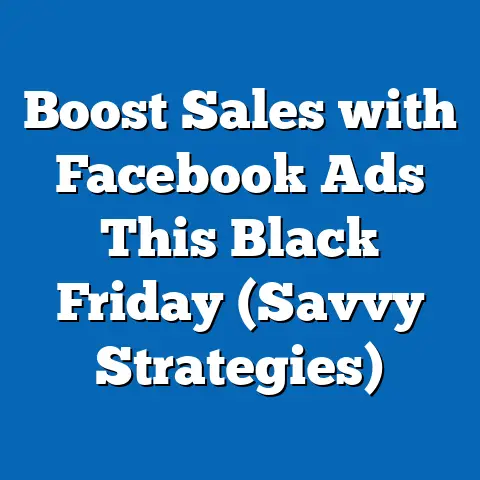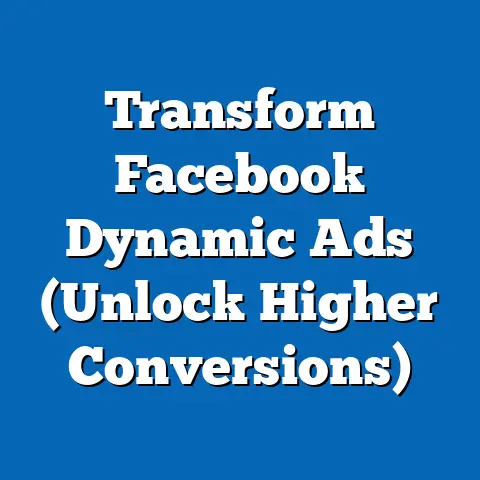Resolve Disapproved Facebook Ads (Expert Solutions Inside)
Resolve Disapproved Facebook Ads: Expert Solutions Inside
Introduction: The Irony of Digital Rejection
In an era where digital advertising reigns supreme, it’s ironic that even the most meticulously crafted Facebook ads can be met with a cold, automated “disapproved” status. Businesses and marketers pour countless hours and resources into creating compelling content, only to be halted by an algorithm that deems their work unfit for the platform. This phenomenon isn’t just a minor inconvenience—it’s a significant barrier in a landscape where Facebook and its parent company, Meta, control a substantial share of global advertising revenue, with over $114 billion earned in 2022 alone (Statista, 2023).
The disapproval of ads on Facebook is not merely a technical glitch; it reflects deeper tensions between platform policies, user experience, and the commercial imperatives of advertisers. For small businesses, startups, and even large corporations, a disapproved ad can mean lost revenue, missed opportunities, and a frustrating cycle of trial and error. This article delves into the defining characteristics of disapproved Facebook ads, explores the historical context of Meta’s advertising policies, analyzes the societal and economic implications, and offers expert-driven solutions to navigate this complex terrain.
As we unpack this issue, we’ll consider the technological, regulatory, and cultural factors at play, while providing actionable insights for advertisers. Our goal is to illuminate why ads get disapproved, how this impacts various stakeholders, and what can be done to resolve these challenges effectively.
Defining Characteristics of Disapproved Facebook Ads
At its core, a disapproved Facebook ad is one that fails to meet the platform’s advertising policies or community standards. These policies are designed to protect users from harmful, misleading, or inappropriate content, but they often leave advertisers grappling with vague guidelines and inconsistent enforcement. Common reasons for disapproval include violations related to prohibited content (e.g., drugs, weapons, or adult material), restricted content (e.g., alcohol or financial products without proper disclaimers), misleading claims, or even technical issues like improper image-to-text ratios.
What makes this issue particularly challenging is the opacity of the review process. Many advertisers report receiving automated rejections with little to no explanation, leaving them to guess what went wrong. According to a 2022 survey by Social Media Examiner, 68% of marketers have experienced at least one ad disapproval, with 43% citing unclear feedback as their primary frustration.
Moreover, the diversity of advertisers—from solo entrepreneurs to multinational corporations—means that the impact of disapproval varies widely. A small business owner might lose a critical sales window, while a larger entity might have the resources to appeal or rework campaigns quickly. This disparity underscores the need for clearer communication and more equitable policy enforcement from Meta.
Historical Context: The Evolution of Facebook Advertising Policies
To understand the current state of disapproved ads, we must trace the evolution of Facebook’s advertising ecosystem. Launched in 2007, Facebook Ads initially operated with minimal oversight, allowing businesses to target users with unprecedented precision based on demographic and behavioral data. This “wild west” era of digital advertising saw rapid growth, but it also led to controversies over privacy, misinformation, and exploitative content.
The turning point came with high-profile scandals like the 2016 Cambridge Analytica incident, where user data was misused for political advertising. Public and regulatory scrutiny intensified, prompting Facebook to overhaul its advertising policies. By 2018, the platform introduced stricter guidelines on political ads, hate speech, and misleading content, alongside enhanced transparency tools like the Ad Library.
These changes, while necessary for user protection, created new challenges for advertisers. Policies became more complex, and automated review systems—powered by AI—were rolled out to handle the sheer volume of ads (over 7 million daily submissions, per Meta’s 2021 transparency report). However, AI systems often lack the nuance to interpret context, leading to false positives and wrongful disapprovals. For instance, ads promoting health products or social issues are frequently flagged for perceived violations, even when they comply with guidelines.
This historical shift reflects a broader tension in digital platforms: balancing user safety with commercial interests. While Meta’s policies aim to create a trustworthy environment, they’ve also fostered frustration among advertisers who feel caught in a bureaucratic web.
Societal and Economic Implications
The disapproval of Facebook ads extends beyond individual businesses—it has far-reaching societal and economic consequences. At a societal level, the stringent policies and automated rejections can stifle free expression, particularly for advocacy groups or nonprofits addressing sensitive topics like mental health or social justice. These organizations often lack the budget to navigate repeated disapprovals, limiting their ability to reach vulnerable audiences.
Economically, the impact is equally significant. Small and medium-sized enterprises (SMEs), which account for 90% of businesses worldwide (World Bank, 2022), rely heavily on platforms like Facebook for cost-effective marketing. A disapproved ad can disrupt cash flow, especially for businesses operating on tight margins. In a 2021 study by Hootsuite, 54% of SMEs reported that ad disapprovals delayed their campaigns by at least a week, with 29% losing over $1,000 in potential revenue per incident.
Moreover, the broader advertising ecosystem feels the ripple effects. Agencies and freelancers who manage ad accounts for clients face increased workloads and client dissatisfaction when ads are rejected. This can strain professional relationships and reduce trust in Meta as a reliable advertising platform. On a macro level, if advertisers shift budgets to competing platforms like Google or TikTok, Meta risks losing market share—a concern given its dominance in the digital ad space.
The implications also touch on equity and access. Larger corporations with dedicated compliance teams can often appeal disapprovals or hire experts to navigate policies, while smaller players are left at a disadvantage. This creates an uneven playing field, where access to digital advertising success is tied to financial resources rather than creativity or merit.
Technological Factors: The Role of AI and Automation
One of the primary drivers of ad disapprovals is Meta’s reliance on artificial intelligence for content moderation. AI systems are designed to flag potential violations at scale, but they often struggle with context and intent. For example, an ad for a fitness program might be rejected for “promoting unrealistic body images,” even if the content is motivational rather than harmful.
This technological limitation is compounded by the sheer volume of data Meta processes. With billions of users and millions of ads submitted daily, human review for every piece of content is impractical. However, the lack of human oversight in initial reviews often leads to errors, as algorithms prioritize caution over accuracy to avoid legal or PR risks for Meta.
Additionally, updates to algorithms or policies are not always communicated clearly to advertisers. A 2022 report by AdEspresso found that 37% of marketers were unaware of policy changes until their ads were rejected. This lack of transparency exacerbates the problem, as businesses are left playing catch-up with an ever-shifting set of rules.
Cultural and Social Factors: Navigating a Global Audience
Facebook’s global user base—nearly 3 billion monthly active users as of 2023 (Meta Quarterly Report)—presents unique cultural challenges for advertisers. Content that is acceptable in one region may violate norms or laws in another, leading to disapprovals based on geographic targeting. For instance, an ad featuring alcohol might be approved for audiences in Europe but rejected for users in countries with strict alcohol advertising bans.
Social trends also influence policy enforcement. In the wake of movements like #MeToo or Black Lives Matter, Meta has tightened rules on content related to gender, race, and social issues to prevent exploitation or harm. While this is a positive step, it can inadvertently penalize legitimate campaigns that aim to raise awareness or drive change.
Advertisers must therefore adopt a culturally sensitive approach, tailoring content to diverse audiences while staying compliant with Meta’s overarching standards. This balancing act is particularly challenging for global brands, which must navigate a patchwork of local regulations alongside platform policies.
Comparing Disapproval Experiences Across Business Sizes
The experience of ad disapproval varies significantly depending on the size and resources of the advertiser. Large corporations often have in-house legal and marketing teams to ensure compliance before submission, as well as the budget to absorb losses from delayed campaigns. When disapprovals occur, they can leverage direct relationships with Meta account managers to expedite appeals—a luxury not afforded to smaller players.
In contrast, solopreneurs and SMEs often lack the expertise or time to decode Meta’s policies. A single disapproval can derail their entire marketing strategy, especially if they’ve invested heavily in a time-sensitive campaign. According to a 2023 survey by Buffer, 62% of small business owners handle their own social media advertising, with 48% citing policy complexity as their biggest barrier to success on Facebook.
This disparity highlights a critical issue: Meta’s one-size-fits-all approach to ad review does not account for the diverse needs and capabilities of its advertiser base. While automation ensures scalability, it often fails to address the nuanced challenges faced by smaller businesses, perpetuating a cycle of frustration and inequity.
Expert Solutions to Resolve Disapproved Ads
Navigating the maze of Facebook ad disapprovals requires a proactive, informed approach. Below are expert-recommended strategies to minimize rejections and resolve issues when they arise. These solutions draw on insights from digital marketing professionals, Meta’s own resources, and industry best practices.
1. Pre-Submission Compliance Checks
Before submitting an ad, thoroughly review Meta’s Advertising Policies and Community Standards. Use tools like the Facebook Ad Library to analyze approved ads in your niche for inspiration on tone, imagery, and messaging. Additionally, ensure that landing pages linked in your ads comply with policies, as Meta often reviews external content during the approval process.
Pay close attention to restricted categories like health, finance, or politics, which require additional documentation or disclaimers. For instance, financial ads may need to include risk warnings, while political ads often require identity verification. By addressing these requirements upfront, you can reduce the likelihood of rejection.
2. Optimize Creative Elements
Technical issues, such as excessive text in images (over 20% of the visual space), are a common cause of disapproval. Use Meta’s Text Overlay Tool to check image compliance before submission. Similarly, avoid sensationalized language like “cure” or “guaranteed,” which can trigger flags for misleading claims.
Test multiple ad variations with different visuals and copy to identify what resonates without violating guidelines. If an ad is rejected, analyze which element likely caused the issue and adjust accordingly. Keeping a clean, professional aesthetic also helps align with Meta’s user experience goals.
3. Leverage the Appeals Process
If an ad is disapproved, don’t assume the decision is final. Use Meta’s Account Quality dashboard to request a review, providing clear explanations or evidence of compliance. Be patient but persistent—some appeals take days or weeks, especially if escalated to human reviewers.
For frequent disapprovals, consider reaching out to Meta support through Business Manager or advertising forums. While direct support is often limited for smaller accounts, documenting repeated issues can help build a case for policy clarification or account assistance.
4. Stay Informed on Policy Updates
Meta frequently updates its policies in response to legal, social, or technological changes. Subscribe to Meta for Business newsletters and follow official channels for announcements. Joining industry groups or forums, such as those on LinkedIn or Reddit, can also provide real-time insights from other advertisers facing similar challenges.
Proactively educate yourself on emerging trends, such as increased scrutiny on data privacy or AI-generated content. Staying ahead of these shifts can prevent unexpected rejections and position your campaigns for long-term success.
5. Work with Experts or Agencies
For businesses with limited time or expertise, partnering with a certified digital marketing agency or Meta Ads specialist can be a game-changer. These professionals are well-versed in policy nuances and can streamline the ad creation and approval process. While this comes at a cost, the return on investment often outweighs the expense of repeated disapprovals.
Alternatively, invest in training for in-house staff through programs like Meta Blueprint, which offers free courses on advertising best practices. Building internal capacity ensures sustainable compliance without relying on external support.
Workplace and Industry Implications
The issue of disapproved ads has significant implications for the digital marketing industry and workplace dynamics. Marketers often face increased stress and burnout when campaigns are delayed or rejected, especially under tight deadlines. A 2022 study by the American Marketing Association found that 39% of social media managers reported policy-related frustrations as a top contributor to job dissatisfaction.
For agencies, repeated disapprovals can damage client trust and lead to lost contracts. This places pressure on professionals to overcompensate by creating overly cautious content, potentially stifling creativity and innovation in advertising. On a broader scale, if advertisers perceive Meta as unreliable, they may diversify budgets across platforms, reshaping the competitive landscape of digital marketing.
Within organizations, the need for compliance expertise has led to the emergence of specialized roles like “ad policy analysts” or “compliance managers.” This trend reflects a growing recognition that navigating platform policies is as critical as creative strategy in achieving marketing success.
Forward-Looking Insights and Uncertainties
Looking ahead, the challenge of disapproved Facebook ads is unlikely to disappear as Meta continues to prioritize user safety and regulatory compliance. Emerging technologies, such as improved AI moderation or blockchain-based transparency tools, may offer solutions by enhancing the accuracy of reviews and providing clearer feedback to advertisers. However, these advancements also raise concerns about privacy and the potential for overreach in content moderation.
Regulatory pressures, particularly in regions like the European Union with laws like the Digital Services Act, will likely force Meta to refine its policies further. While this could lead to greater accountability, it may also introduce new layers of complexity for advertisers. The balance between innovation and restriction remains a key uncertainty.
For advertisers, adaptability will be crucial. Building resilience through diversified marketing channels, continuous learning, and strategic partnerships can mitigate the impact of disapprovals. As the digital landscape evolves, those who embrace flexibility and proactive problem-solving will be best positioned to thrive.
Ultimately, resolving disapproved Facebook ads requires collaboration between Meta, advertisers, and regulators. By fostering transparency, improving AI tools, and prioritizing equitable access, the platform can create a more inclusive advertising ecosystem. Until then, advertisers must arm themselves with knowledge, patience, and expert strategies to navigate this ever-changing terrain.
Conclusion
The irony of disapproved Facebook ads lies in their ability to frustrate even the most seasoned marketers in a digital-first world. While Meta’s policies aim to protect users, they often leave advertisers caught in a web of automation, opacity, and inconsistency. The societal and economic implications—from stifled small businesses to strained industry dynamics—underscore the urgency of addressing this issue.
Through a historical lens, we see how past controversies have shaped today’s stringent policies, while technological and cultural factors continue to complicate the landscape. Yet, with expert solutions like pre-submission checks, optimized creatives, and strategic appeals, advertisers can reclaim control over their campaigns.
As we look to the future, the path forward remains uncertain, shaped by technological innovation, regulatory shifts, and evolving user expectations. What is clear, however, is the need for a balanced approach—one that prioritizes both user safety and advertiser success. Until that equilibrium is achieved, businesses must remain vigilant, resourceful, and ready to adapt in the face of digital rejection.





